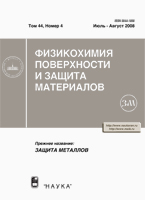To the Tafel Slopes at the Anodic Dissolution of Iron in Sulfuric Electrolytes
Yu. P. Vishnevskaya, D. A. Tkalenko, M. V. Byk, and V. A. Rupp
National Technical University of Ukraine (KPI), pr. Pobedy 37, Kiev-56, 03056 Ukraine
E-mail:
Этот e-mail защищен от спам-ботов. Для его просмотра в вашем браузере должна быть включена поддержка Java-script
Received March 21, 2007
Abstract — Based on the hypothesis of the reversibility of an iron electrode, one can relatively easily explain the experimentally obtained Tafel slopes without multistage complex schemes involving hypothetic intermediate iron hydroxo compounds. On the other hand, the coincidence of the experimental slope with the slope following from the relation derived may be considered as a proof of the reversibility of the iron electrode. The Tafel slope is reproducible both on the clean and partially passivated iron surface.
PACS numbers: 82.45.Bb
DOI: 10.1134/S003317320705013X
